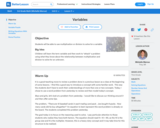
Students can solve multiplication and division problems quickly by recognizing the relationship between the two operations.
- Subject:
- Mathematics
- Material Type:
- Lesson Plan
- Provider:
- BetterLesson
- Date Added:
- 12/01/2022

Students can solve multiplication and division problems quickly by recognizing the relationship between the two operations.

Children will learn the term variable and then work to "attack" a problem using what they know about the relationship between multiplication and division to solve for an unknown.

In this lesson, students read and discuss an article about video games and violence, then participate in a debate. They are divided into groups and each group prepares an argument and their evidence, then one person from each group presents their position to the class.

Have you ever wondered what the magic kingdom would look like on a coordinate grid?

Students will look at examples of illustrations and diagrams in informational texts and discuss how each one helps enhance the text. Students gain the knowledge that sometimes a picture is worth a thousand words because a complex idea can be explained with just a single image. Included are printable handouts, videos of student work, and rubrics for assessment.

Making connections between art, math, and the real world helps students understand integers in our daily lives.

Kindergarteners take ownership of the JUICY words they learn by hearing them, practicing them, and checking them. The following routine supports children to own their words! Instead of the teacher introducing the word and giving the definition to students, students are involved in the process of explaining the word and are in charge of remembering enough to teach each other!

Students will be doing their own illustrations of the vocabulary words from "Look Out Kindergarten, Here I Come!" Students will also practice the skill of sequencing.

Choose from a variety of lessons to help your students write an effective opinion piece.

Links to 37 lessons that focus on skills within third grade reading standard W.3.1.

Links to 12 lessons and activities that build student skills in standard W.3.1a: Introduce the topic or text they are writing about, state an opinion, and create an organizational structure that lists reasons.

Links to 27 lessons and activities that build student skills in standard W.3.1b: Provide reasons that support the opinion.

Links to 11 lessons and activities that build student skills in standard W.3.1d: Provide a concluding statement or section.

Links to 56 lessons and activities that build student skills in standard W.3.2: Write informative/explanatory texts to examine a topic and convey ideas and information clearly.

Links to 18 lessons and activities that build student skills in standard W.3.2a: Introduce a topic and group related information together; include illustrations when useful to aiding comprehension.

Links to 12 lessons and activities that build student skills in standard W.3.2b: Develop the topic with facts, definitions, and details.

Links to 7 lessons and activities that build student skills in standard W.3.2c: Use linking words and phrases (e.g., also, another, and, more, but) to connect ideas within categories of information.

Links to 8 lessons and activities that build student skills in standard W.3.2d: Provide a concluding statement or section.

Links to 47 lessons and activities that build student skills in standard W.3.3: Write Narratives to develop real or imagined experiences or events using effective technique, descriptive details, and clear event sequences.

Links to 2 lessons and activities that build student skills in standard W.3.3.b: Write Narratives to develop real or imagined experiences or events using effective technique, descriptive details, and clear event sequences.